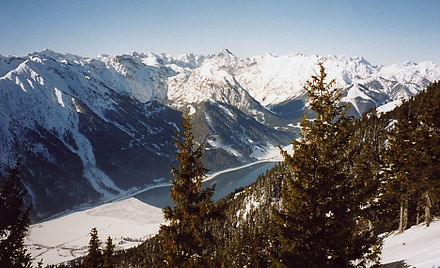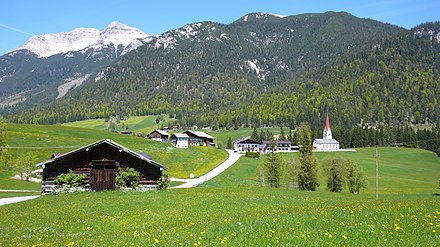Achen Valley - reservoir
The Achen Valley is an Alpine valley in Tyrol and known for its lake, the Achen Lake, with a surface of 6.8 km² it is the largest lake in Tyrol.
Towns
- Eben am Achensee - The south and west of the Achen Valley, covered by large swaths of the Karwendel Nature Park. Its towns, Maurach and Pertisau are popular holiday resorts.
- Achenkirch - The largest town in the Achen Valley and popular ski resort in winter with extensive ski infrastructure. It sits at the border with Bavaria.
- Steinberg am Rofan - A somewhat reclusive small town with only 280 inhabitants deep in the Rofan mountain range
Other destinations

Understand
 The valley is dominated by a fjord-like mountain lake named Achen Lake (German: Achensee) at an altitude of 926 m. The 3 settlements around the lake, Achenkirch, Pertisau, and Maurach, are all popular travel destinations especially in the summer months, but there is also limited winter sports infrastructure: Achenkirch is the best developed ski resort in the valley. The water level in the lake is 6 m lower in winter and spring because water is drawn to Jenbach to generate hydroelectricity.
The valley is dominated by a fjord-like mountain lake named Achen Lake (German: Achensee) at an altitude of 926 m. The 3 settlements around the lake, Achenkirch, Pertisau, and Maurach, are all popular travel destinations especially in the summer months, but there is also limited winter sports infrastructure: Achenkirch is the best developed ski resort in the valley. The water level in the lake is 6 m lower in winter and spring because water is drawn to Jenbach to generate hydroelectricity.
The water in the lake is near drinking water quality and safe for water sports activities and swimming, although the water temperature rarely reaches above 20°C. The water is crystal clear with a sight up to 10 m under water, creating the perfect conditions for diving since the lake has a maximum depth of 133 m. The size and wind conditions make it also very suitable for wind surfing.
AchenseeCard

History
Upon completion of the Lower Inn Valley Railway in 1859, tourism started to flourish and spread to neighbouring valleys including the Ziller valley and the Achen valley. At the time, the lake was in the possession of the St. Georgenberg-Fiecht Abbey, who had owned the lake since 1120. To generate profit for the abbey, a first steamboat was deployed on the lake in 1887, and the construction of the Achenseebahn, a narrow gauge track railway with a length of 7 km commenced. The end station of the Achenseebahn, Seespitz, remains on the shores of the lake today and enables seamless transfer of passengers from train to boat. The service became popular and a second steamboat was added to increase capacity. In 1890 both boats transported around 30 000 passengers on the lake.

The First World War left infrastructure in disrepair, and management of the lake's potential as tourist destination fell out of scope of the abbey, which decided to sell the lake to the City of Innsbruck in 1919. A motorboat was added in 1925, and the threshold of 100 000 passengers was reached for the first time in 1927.
Get in
By train
Intercity trains on the Munich — Rosenheim — Innsbruck line also stop in Jenbach in the Lower Inn Valley. Take [undefined] bus 4080 near Jenbach station 📍 towards Achensee. A more nostalgic alternative is the historic Achen Lake Railway (German: Achenseebahn)) combined with a ferry on the lake for further travel, however this option is considerably more expensive. The Achen Lake Railway only operates during summer months, so during the winter holiday season a bus is the only option.
By bus
There is a bus connection from Tegern Lake (German: Tegernsee) with a rail connection to Munich. [undefined] bus 9550 stops in Achenkirch, Buchenau, and Maurach. The terminus is in Pertisau. A single ticket from Jenbach to Maurach costs €3.80.
By bike
There are 2 cycle paths offering a scenic route into the Achen Valley:
- Via Bavarica Tyrolensis — Roman road now in use as cycle route connecting Munich with Jenbach in the Lower Inn Valley. The path passes Achen Lake.
- The Inn cycle path — from Jenbach cycle up the mountain to Achen Lake (ca. 400 m difference in altitude). There are 2 roads, the very busy state motorway B181 (lots of traffic, not recommended) and the less frequented but much steeper L7 📍.
Get around
By bus
The 2 bus lines crossing the valley are bus [undefined] 4080 and bus [undefined] 9550. Their schedules are somewhat complementary.
By boat
To get from one side of the lake to the other, the ferry may be faster than the bus. There are 6 ferry ports: [undefined] Pertisau 📍, Seespitz 📍, Buchau 📍, Gaisalm 📍, Achenseehof 📍, and Scholastika 📍. Ports are on more or less alternating shores of the lake, making crossing the lake easier. A complete round tour of the lake takes about 2 hours, but tickets between stops can also be purchased. It is recommendable to purchase tickets in advance online.
See
Do
Winter sports
Although not as famous as its neighbours in the Ziller Valley and Stubai Valley, which can brag with their 3 000m peaks, some winter sports infrastructure is slowly emerging in the Achen Valley. The altitude is relatively low, between lake water level at ~929m and ca. 1 850m for the mountains in the Rofan and Karwendel ranges. On the outskirts of the Alps, the Achen Valley is often suffering from a lack of snow, especially at lower altitudes, so don't expect the highest quality snow here. The infrastructure depends on snow cannons most of the year, and skiers may find slopes at lower altitudes to be closed due to a lack of snow.
On the other hand, the lower altitude makes temperatures mild compared to the icy winds on the Hintertux glacier at the end of the Ziller Valley, so you may find people skiing in a T shirt in spring!
{| class="wikitable" !Name||Tel.||Altitude||
/
/
||
/
/
|- |Karwendel Cable Car 📍|| +43 5243 5326 ||960 - 1 560m||7 Lifts: 1 / 4 / 2|| 12 km Pistes: 6 / 6 / 0 |- |Ski resort Rofan 📍|| +43 5243 5292 ||985 - 1 840m||4 Lifts: 1 / 2 / 1|| 11 km Pistes: 1 / 8 / 2 |- |Ski resort Christlum 📍|| +43 5246 6300 ||950 - 1 800m||13 Lifts: 0 / 4 / 7|| 27 km Pistes: 6 / 16 / 5 |- |Rofan lift Steinberg 📍|| +43 5248 293 ||1 050 - 1 250 m||3 Lifts: 0 / 0 / 3|| 1 km Pistes: 1 / 0 / 0 |} Ski passes can be purchased per day, or for multiple days, at any of the valley lifts. When purchasing a ski pass for 5 days in a row in Achenkirch, for a fee of €175, there is the option of make it valid in the entire region (all ski areas) for an additional €5.
Venues for ski equipment rental are limited in the Achen Valley, and the few available rental shops charge exuberant rates following their near monopoly market position. This is especially the case in Maurach and Pertisau. Expect to be ripped off if you find yourself in the unpleasant situation where purchase of replacement gear is necessary — skiers have reported to be charged as much as €40 for a pair of ski gloves and over €110 for the cheapest ski goggles! It is advisable to bring your own skis and gear in from outside the valley. If you need to rent gear, the neighbouring Ziller Valley may be a more cost effective option because there is a healthier competition between rental services.
Eat
The Achen Lake offers an abundance of fresh water fish, which is served in many of the surrounding restaurants. Game meat from surrounding Karwendel and Rofan mountains is widely available. Goat and sheep cheese are produced and served as delicacies, just like locally produced honey. Agriculture has historically been difficult in the Achen Valley because of its climate and soil, so the regional cuisine developed around dairy, meat, and fish rather than vegetables — potatoes being a notable exception. Those with a preference for vegetarian or vegan lifestyle should expect difficulty food to their taste in local restaurants, as many do not offer vegetarian or vegan alternatives.
The Achen Valley is famed for its variety of breads, of which some are only baked in the towns around Achen Lake. The Adler bakery 📍 in Achenkirch is a good starting point to explore local bread, with live demonstrations of bread baking in a wood fired oven.
Drink
The fresh water of Achen Lake is famous for its excellent water quality, which is nearly drink water. Many of the springs surrounding the lake produce crystal clear spring water that is safe to drink, and on top of that, ice cold!
For those looking for something stronger, the Achensee Bier is a wheat beer (German: Weißbier) with an alcohol content of 4.8% and a fruity flavour brewed since 2010. It originates from Pertisau, and can be tasted in the Langlaufstüberl 📍 on the outskirts of Pertisau, and in many other pubs around town.
In Maurach, Edelbrennerei Kostenzer 📍 produces over 70 varieties of alcoholic drinks including gin and whisky, and many liquors based on locally sourced fruits (apples, plums, apricots) and forest berries.
Stay safe
The Achen Valley is a very safe area, with low crime levels. Violent crime is almost unheard of. Pickpockets on the other hand are quite common in touristy areas, particularly pubs and bars. Don't leave skis unattended in areas that can be reached without cable car access (around the base stations of cable cars for example) as they risk being stolen. Insuring skis against theft is a good idea. Rental skis are tagged by their operator and less likely to be stolen.
Around bars and pubs incidents occasionally occur with drunk tourists who underestimate how strong Achensee beer or liquors are. These troubles are very localized though, and steering away from them is enough to keep you safe.
The mountains themselves pose their own threat, especially in winter. Wildlife will be the least of your worries, however, rapidly changing weather conditions and unexpected ice/snowfall could change a pleasant mountain hike into a life threatening situation very quickly if you're unprepared to deal with mountain weather. Take the necessary precautions, most notably when venturing into the vast Karwendel National Park where accommodation or help is difficult to find if you'd happen to get into trouble.
Go next
Tyrol
Primary administrative division
